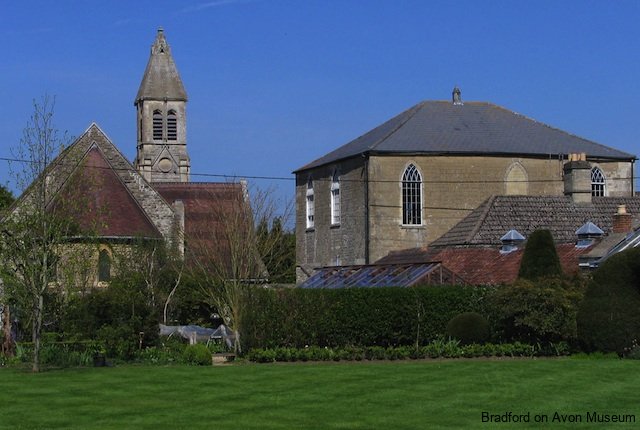.
Holt United Reformed Church
Holt, Bradford on Avon, Wiltshire
.

The two church buildings seen from The Courts Garden
.
The square building with almost pyramidal slate roof had been built as an Independent Church by 1813 for £220, probably succeeding a congregation that had been meeting in the assembly room of the White Hart (now Toll Gate) public house. It was extended to the present size in 1846 for £330 and had become a Congregational Church by 1859.
Later in the 19th century the rather typical Georgian nonconformist chapel was replaced by another building in the shape of a more conventional mainstream church. It was designed by William Jervis Stent (1815-1887) in a Victorian gothic style with an apse and a tower capped with a spire and built of stone from Atworth by John Ponton of Warminster, cost £2,181 to seat 280. The architect was from Warminster, where he designed several buildings, including the Athenaeum in 1858. A memorial stone (not a foundation stone -it is much higher than the foundations) was laid by Edwin C. Beaven on Wednesday 2nd June 1880. It was opened, in a snow storm, on Thursday 18 November 1880, with a sermon from Rev John Guiness Rogers BA of London (late Chairman, London Congregational Union). A dinner was held, chaired by Handel Cossham from Bristol and a lecture was given by Rogers on “Nonconformity” with Thomas Harris, the bacon and ham curer from Calne, in the chair.
On the merger of the Congregationalists with the Presbyterians in 1972 it took the name United Reformed Church.

The old church was retained and became the nonconformist school for the village, merging with the Anglican National School in 1938. A new joint school was built by the County Council at The Gravel in 1962, but infants continued to be taught at the old chapel until the present school was extended in 1973. In 1974 a planning application was made to demolish the building and replace it with a smaller prefabricated church hall, but this was refused and restoration and conversion was carried out in the following year instead.




